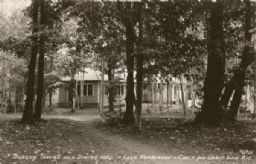
My second source, an excerpt from The Flavor of Wisconsin, will be a great resource for my research. I chose this scource because it is an informational history book about food and eating in the badger state. This book has a picture of a sign for a fish broil on the front page, so it gave me a great first impression when looking into sources relating to fish fries in Wisconsin. This one in a half page chapter has so much information relating to fish fries in Wisconsin. The chapter; “Thank God It’s Friday Fish Fry”, is goes in depth about how food connects on a greater scale with regional culture through “history, geography, ethnicity, and religion”(Allen & Hatchen).
Some rhetorical context and information about this source includes how credible the source is. I think it is a great source for me to use based on The Flavor of Wisonsin having a second edition. The original was revised and improved with more information to the print that I used, the second edition.
The way the chapter is organized makes connecting information together be easy. Questions are used to introduce a specific topic or general idea and then historical and other information and facts are explained to back up the question. For example, in the beginning paragraphs of the chapter two questions are asked to probably help readers understand what they will learn in the future paragraphs of the chapter as well as make readers brainstorm their own ideas relating to the question even prior to learning chronological historical information. The questions are: “Why fish fry? And, How did it start, and why does it thrive in Wisconsin?” These questions are very straightforward and they really helped me in terms of my overall research question.
The chapter deeply explains how and why the Indigenous tribes like the Ojibwe depended on the fish supply from the Great Lakes. The chapter then goes on to connect the Ojibwes relationship with Eurpoean explorers and how the two groups shared culinary practices. The populatin in Wisconsin expanded and the European and Yankee settlers used the areas large white fish population to create jobs and provide affordable food. The idea of fish fries expanded tremendously because Wisconsin citizens had a good, cheap system of feeding large populations at social events like church gatherings, community picnics, and other events. (Hachten & Allen) “Certainly Wisconsin’s large Catholic population, many members of whom did not eat meat on Fridays, was a factor in the popularity of fish in the region” (Hachten & Allen). The next idea of the chapter relates to the time of Prohibition. Foklore professor, Janet Gillmore, from the University of Wisconsin-Madison has information on how fish fries becoame so important to bar owners during the Prohibition. She notes, “that’s when bar and tavern owners, desperate for business that the alcohol ban had taken away, lured customers of all kinds to their establishments by offering “free lunches” of fish and selling alcohol under the table.” Gillmore then states; “After Prohibition, they brought customers back by providing cheap and peniful Friday night fish fries that large Catholic families could afford.” Gillmores ideas are so important to me as a researcher because now I have greater knowledge to a specific time in history where Wisconsin fish fries bloomed. The last important information I took away from reading this chapter was information relating to Wisconsins large German heritage and the word gemutlichkeit, “the German concept that connotes geniality, hospitality, and good fellowship, often in a context of food and drink”(Allen and Hatchen). The Wisconsin phenomenon of fish fries fits this German “party culture” exactly. Hachten and Allen say, “it’s not just a meal;it’s a social event, an end-of-the-work-week celebration that is as much about camaraderie as it is about food”(Allen & Hatchen).
Overall, the chapter gives a great historical and background understanding of how fish fries grew to become so popular within Wisconsin. I wish the chapter would’ve included specific people or examples of where fish fries took place throughout history.
Works Cited:
Allen, Terese. Hachten, Harva. “Thank God It’s Friday Fish Fry.” The Flavor of Wisconsin : An Informational History of Food and Eating in the Badger State. Second ed. Madison : State Historical Society of Wisconsin, 2009. 93-94. Print. Revised and Expanded.

